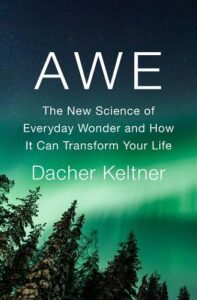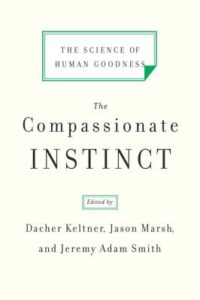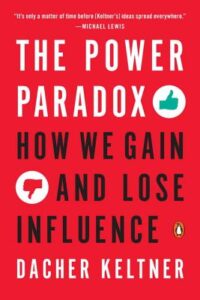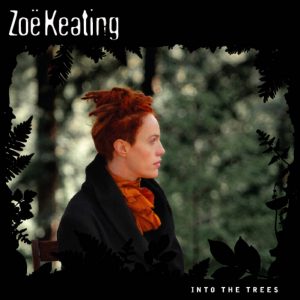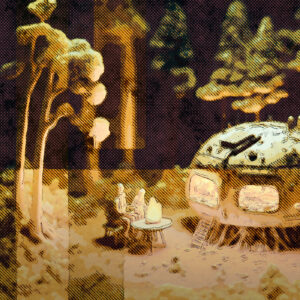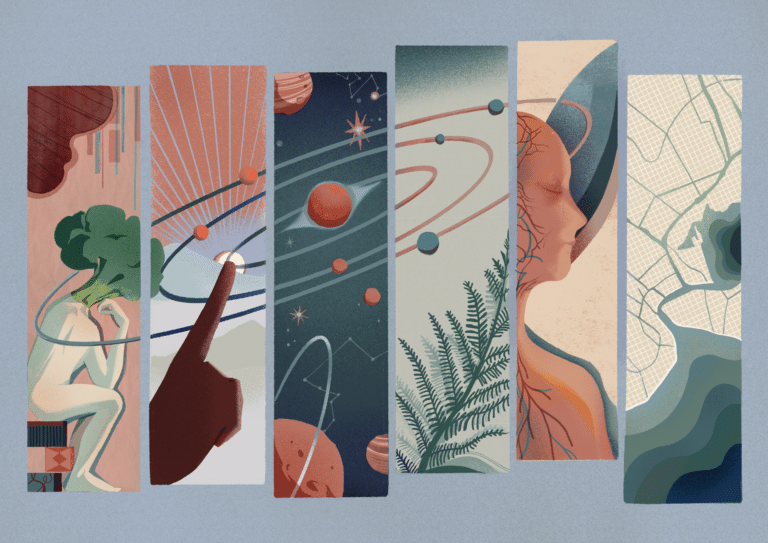Dacher Keltner
The Thrilling New Science of Awe
One of the most fascinating developments of our time is that human qualities we have understood in terms of virtue — experiences we’ve called spiritual — are now being taken seriously by science as intelligence — as elements of human wholeness. Dacher Keltner and his Greater Good Science Center at Berkeley have been pivotal in this emergence. From the earliest years of his career, he investigated how emotions are coded in the muscles of our faces, and how they serve as “moral sensory systems.” He was called on as Emojis evolved; he consulted on Pete Docter’s groundbreaking movie Inside Out.
All of this, as Dacher sees it now, led him deeper and deeper into investigating the primary experience of awe in human life — moments when we have a sense of wonder, an experience of mystery, that transcends our understanding. These, it turns out, are as common in human life globally as they are measurably health-giving and immunity-boosting. They bring us together with others, again and again. They bring our nervous system and heartbeat and breath into sync — and even into sync with other bodies around us.
Guest
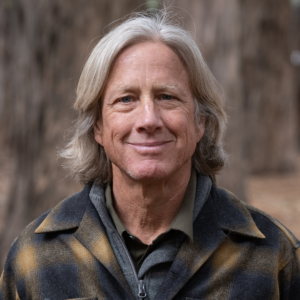
Dacher Keltner is a professor of psychology at the University of California, Berkeley, and founding director of the Greater Good Science Center. He hosts the podcast The Science of Happiness. His latest book is Awe: The New Science of Everyday Wonder and How It Can Transform Your Life.
Transcript
Transcription by Alletta Cooper
Krista Tippett, host: To me, one of the most fascinating developments of our time is that human qualities we have understood in terms of virtue — experiences we’ve called spiritual — are now being taken seriously by science as intelligence — as elements of human wholeness. And Dacher Keltner and his Greater Good Science Center at Berkeley have been pivotal in this emergence.
From the earliest years of his career Dacher investigated how emotions are coded in the muscles of our faces, and how they serve as “moral sensory systems” — the way a feeling, like sadness or fear or a sense of injustice, goes on to infuse how we see everything that’s happening.
[music: “Seven League Boots” by Zoë Keating]
He was called on as Emojis evolved; he consulted on Pete Docter’s groundbreaking movie Inside Out. And all of this, as Dacher sees it now, led him deeper and deeper into investigating the primary experience of awe in human life — moments when we have a sense of wonder, an experience of mystery, that transcends our understanding. These, it turns out, are as common in human life globally as they are measurably health-giving and immunity-boosting. They bring us together with others, again and again. They bring our nervous system, and heartbeat, and breath into sync — and even into sync with other bodies around us. This science is a wildly accessible, minute-to-minute invitation to practice a common human experience that is literally life-giving, and nourishing, and actively good for this world of pain and promise that we inhabit.
I’m Krista Tippett, and this is On Being.
I’ve been in a conversation of friendship and shared curiosity with Dacher Keltner for years, and I’m so happy to bring this conversation to you as he has now translated his studies into a book: Awe: The New Science of Everyday Wonder and How It Can Transform Your Life.
Tippett: So, I want to start at the beginning, which is where I like to start.
Dacher Keltner: OK.
Tippett: And it seems to me that so much — I mean, at the beginning of you, right? [laughs]
Keltner: [laughs]
Tippett: It seems to me that so much of your science — one way to talk about it, there are many ways to talk about it, but one way to talk about it is you are taking the stuff of what has always been moral virtue, and you’re taking it into the laboratory. So I start to wonder, just knowing a little bit about you. Where — if you would trace, I know that you had a rather kind of experimental, unorthodox, spiritual upbringing. [laughs]
Keltner: [laughs] Oh, no. Yeah.
Tippett: So I wonder if you look back at that, and if you trace the roots of this inquiry in you, this curiosity, and the way you’ve come at it.
Keltner: Oh yeah. You know, there are times in a scientific career where we believe we’re doing work that has some degree of objectivity, where you realize it’s all subjective and personal. You know, I was raised by a literature professor who loves romanticism and Virginia Woolf and quoted William Blake and others in the household. And then a visual artist, my dad, who loves Goya and Francis Bacon and all the horrors of their art, and the awe-inspiring horrors. And I grew up in a really, kind of a radical time of the late ’60s and Laurel Canyon. And so awe was all around me. And I think that being raised by people in the humanities and being a little contrarian, I guess, like kids often are, I always wanted proof [laughs].
Tippett: Right.
Keltner: And I wanted to measure things and I wanted to test things. And so it’s very fitting that, at this stage in my life, I would turn to science to figure out awe. And so yeah, it — and to find in that science and the limits of the science, sort of the what lies beyond it, which is the metaphysical or the spiritual. And so studying awe really brought me into contact with spirituality, too.
Tippett: And then, it’s so interesting to me that you really wandered into a new science as it was emerging, right?
Keltner: Yeah.
Tippett: I mean, I’ve had this conversation with other neuroscientists as well. And it’s really easy, I think, for people now to forget that this particular form of science has just been around for a few decades.
Keltner: Yeah.
Tippett: And you were right there at the beginning. It feels like you walked into this new science of emotions, which science had very, very strictly avoided. And it was really new for you to be taking things like laughter and gratitude and love and desire and compassion into study.
Keltner: You know, it was astonishing to me. I was in graduate school in the mid to late ’80s at Stanford. And it was the heyday of what’s called the “cognitive revolution.” And the metaphor was that the human mind was like a computer with software and hardware, and cranking out these algorithms and computations, and that’s consciousness. Right?
And some of the most famous people in the field just felt like emotions couldn’t be studied, it was inappropriate to study them. They were intractable in terms of measurement and conceptualization, or how we would even measure them. And I just felt my past at that time of being raised by these wonderfully emotional parents, who are like — but what about poetry and what about paintings and what about the feelings you have? And what would human life be like without crying and laughter? So it was astonishing to just hear the brightest minds say: there’s no place for human emotion in prejudice, in racism, in morality — literally. Carrying on Western European traditions, in many ways. But what a great opportunity to fall into as a young scholar.
Tippett: So now you have written this wonderful book, the first lines, “I have taught happiness to hundreds of thousands of people around the world. It is not obvious why I ended up doing this work: I have been a pretty wound-up, anxious person for significant chunks of my life and was thrown out of my first meditation class.”
Keltner: [laughs] Which is true.
Tippett: So thank you for that full disclosure. [laughs]
Keltner: Yeah. I have to say, my friend and I in college went to this meditation class, and they had us chanting, “I am a being of purple fire.”
Tippett: Yeah, which is a reason to laugh. I give you that.
Keltner: Yeah. And I’m like, “I’m not a being a purple fire. I’m an adolescent who wants to meet interesting people.” And so yep. We got tossed out of that class. So — [laughs]
Tippett: But I mean, yeah. And you — I’ve been following your work, off and on for many years, and this really has deepened and deepened and deepened into this, this study of awe. And you say now after 20 years, you have the answer to the perennial question: how to live a good life? And the answer is: to “find awe.” And so tell me if, is this right? You’ve done these massive studies, right? I don’t know, somewhere I’ve got 2,600 narratives, 20 languages.
Keltner: Yeah.
Tippett: And were you surprised? I kind of was — to read that what most commonly led people around the world to feel awe was an experience of other people’s “courage, kindness, strength, or overcoming.”
Keltner: Yeah. You know, the first surprise was: it’s other people around us — everyday people — who bring us awe, and what we called moral beauty.
Tippett: And I love that language, “moral beauty.”
Keltner: Yeah, kindness, courage, overcoming obstacles. You know, saving people’s lives. Just time and time again the most common source of awe is other people. And you wouldn’t think that given what we look at on Twitter and Instagram, but it’s a deep, a deep tendency to choke up and get tears thinking about what people can do.
Tippett: And so you kind of named — and this is how the book is structured, around “Eight Wonders of Life.” And I mean, I’m assuming I hear that as in interior analogs to what we call Wonders of the World. Is that right?
Keltner: I think we need new Wonders of the World.
Tippett: Right!
Keltner: You know, you look at those, and those are all power based.
Tippett: Those are monuments, right?
Keltner: What nonsense, you know?
Tippett: Yeah. Go on. Go on.
Keltner: Well this is saying, that’s like a hierarchical conceptualization of wonder, like what did the guy in charge in the Egyptian period do?
Tippett: That’s right. Make thousands of people do —
Keltner: Yeah. Or Trump Tower or whatever. But, you know. But yeah, and that was this big surprise in this research, is how ordinary awe can be. It’s everywhere, right? So it’s the flowers blooming and the moral beauty of people, and some pattern of light on the sidewalk. So yeah, we called them “Eight Wonders of Everyday Life.”
Tippett: Yeah. So what I would like to do is — obviously we can’t walk through it all, but I just kind of went through myself and pulled out some threads…
Keltner: That’s good.
Tippett: … that intrigue and illuminate and turns a phrase that for me, put something into a new light. So I just like to walk through it that way. And yeah, first of all, there is this, what you call the first wonder of life, “moral beauty.”
Keltner: Yeah.
Tippet: And there’s also, there’s this — in terms of this moral beauty of awe at the kindness and strength and courage and overcoming of others, you use this phrase: “allowing goodness its own speech.” So what is that? What does that mean to you? Or how did that come out of the research?
Keltner: Well it comes — “allowing goodness its own speech,” comes out of a graduation speech by Toni Morrison, the great writer, who said this is what she sees to be the purpose of her creative life and literature and the like. And Krista, I mean obviously we live in these times where you arrive at a really cynical view of human beings. And that cynical view, I might add, has prevailed in a lot of the social sciences, and it’s been refuted — that people actually share instinctively, we cooperate, we have neurophysiological systems that help us care for a lot of people. It’s, as Darwin said, sympathy is our strongest instinct.
Tippet: Yeah.
Keltner: And what struck me about the ease with which people around the world would, like, “Hey, what’s awe inspiring?” They didn’t mention a God or the Grand Canyon. They mention ordinary people doing amazing things. And so I felt like that scientific act was “allowing goodness its own speech.” Like, man, this just surfaces in how people think about the transcendent.
And I hope — you know I just, I think we need more of that. We need more stories around goodness and this human capacity. So for me, like I said, I can get really tense and anxious. I can be a little misanthropic. I hate to say it. [laughs]
Tippet: [laughs] Yeah.
Keltner: You know, I wasn’t the kindest little kid. And this science was like: wow, there is a lot of goodness out there that we need to allow its articulation.
Tippett: So the second one is “Collective Effervescence.” And what wonderful language for what you’re describing is, again, so ordinary and built into all kind of life.
Keltner: Oh my god. Yeah. “Collective Effervescence.” Émile Durkheim, the great French sociologist: just moving together, feeling exalted, bubbling, being ecstatic, is just this deep tendency. Young people feel it all the time. You know, they dance, and they go to political rallies and sporting events and world —
Tippett: Right.
Keltner: But it’s everywhere. You know, once I started to think about this — I love walking in Berkeley, and Berkeley’s this buzzing, high-energy place. And you would see these patterns of collective effervescence that the science is starting to capture, you know. People walking to work, little kids going to a dance class, people at a picnic, people lining up to get onto a bus. We just have this tendency to start to move together.
Tippett: Right.
Keltner: And it brings us a lot of sense of unity and a sense of awe. And if you really push it in the right context, bliss. [laughs] And a sense of like, “Wow, look at what I’m part of. You know, I’m part of this human — this collective.” What a striking tendency we have.
And I, as I started to dig into this concept, I love Søren Kierkegaard’s quote. You know, this grouchy philosopher writing about dread. He’d go out and walk, and he would say: it puts me into contact with the significance of insignificant things. You know? And that’s how I felt, like man, watching kids line up to go play is awesome. Or marching to their preschool in their incredible ways.
Tippett: Well, yeah. And you have this phrase also — that somehow what becomes collective effervescence has to do with moving the way our bodies “were meant to move.”
Keltner: Yeah.
Tippett: Which is so interesting to think about. But everything you’re talking about though, we do so unconscious of the fact that this is primal and life-giving. Right? Which is what you’re saying, what the science is saying.
Keltner: Yeah. You know, I mean, almost all cultures have deep histories and traditions of dance. I was just in the Himalayas, in Bhutan for this project, and the Layap people dance all the time. You know, they have a government ceremony and then they dance. And that is very human to move in unison like that. And it’s, as you said, Krista, it’s life-giving. And I hate juxtaposing with our screen-based, chair-based life, but we’ve lost that. And, but I see young people moving back to it of board games and dance clubs and, so I have hope we can return to it.
[music: “Blue Latex” by Blue Dot Sessions]
Tippett: I mean, you also use this, you say “awe is an emotion of the superorganism.”
Keltner: [laughs]
Tippett: And I’ve heard you talk about this in a few contexts, and I want you to talk about the superorganism because I guess — is collective effervescence also an expression of this when this happens? When we’re together in these gatherings having these experiences?
Keltner: Yeah, and this is where the science is really cool, which is that, you know, you can get people and they start moving in unison. Like in experiments you have them walk in unison or move their — do some gestures in unison. And they’re like, okay, this is kind of artificial, or it doesn’t have the power of dance or a political rally. But then their brains start showing similar patterns of activation throughout the 80 billion neurons that are their brains. And their physiologies, their cortisol, and their hormones start linking up. And the next thing you know, it’s like, well, we’re kind of this a shared mental state. And—
Tippett: And you can measure that, right, with your science now?
Keltner: Yeah, definitely. You know —
Tippett: You can measure that we literally physiologically sync up in all kinds of minute ways.
Keltner: Yeah. I mean, one study had people listen to music together, and their brains started to synchronize — people in the music venue — in a similar pattern of activation. So they’re literally, their neurophysiological mental state is similar.
We did a study of really poor kids and veterans rafting, and we measured the hormone cortisol, which is a stress hormone. At the start of the day, their hormone levels were all different. They’re separate individuals. By the end of the day, after having rafted with a little collection of people, their hormone levels are the same. Lots of data on that. And, and that’s striking that these processes of collective effervescence — you’re doing rituals in a church, right? You’re chanting at a game. You are greeting people in a ceremony. They sync us up physiologically, which enables lots of good things.
Tippett: Yeah. Oh gosh, it’s so fascinating.
Keltner: Yeah.
Tippett: And then of course nature, which is maybe what I would’ve expected to be the first, from 2,600 narratives. I might have thought that the most stories would be about awe of the natural world. And of course, it’s in here, and it’s important. And some of the things you’re describing happen outside. But I want to hear more about the neurophysiology, what you call “the neurophysiology of wild awe.”
Keltner: Yeah.
Tippett: Which I guess is that awe that happens outdoors, in the wild.
Keltner: Yeah. It is a universal. It might be mushrooms in Russia, or the desert landscape in part of the Middle East, or the ocean for surfers — but nature is directly evocative of awe, but not as much as other people, which surprised us.
And the neurophysiology is amazing. It is truly amazing. And it gets back to this old indigenous idea of — we are part of an ecosystem, our bodies are part of them. So there’s a review of how nature benefits us, and there are 21 pathways by which that’s true, including awe. But what really struck me is the neurophysiology, which is, you know — sound waves coming off of streams, and moving bodies of water, activate the vagus nerve. They calm us down. There are chemical compounds in nature. You might smell a flower or tree bark, or the resin on a tree, that activate parts of the brain and the immune system, right? So our bodies are wired to respond in an open, empowering, strengthening way to nature. That work is largely done in Japan and South Korea.
Tippett: Interesting.
Keltner: And I think one of the broader lessons that awe provides for us is, you know, these ideas of separate self. Like, “oh, I’m different from other people.” Which is true, but we’re also synced up with other people. “I’m different from nature.” That’s true. But we’re also part of an ecosystem.
And I’m always persuaded by certain kinds of physiological data, which say like, man, you’ve got cells in your skin that are tracking chemicals in nature that benefit you. So it’s striking to me, the uses and meaning of that science.
Tippett: And, and you mentioned the vagus nerve, which is our favorite nerve here at On Being. [laughs]
Keltner: That makes me tear up, I have to say. [laughs]
Tippett: [laughs] Yeah, I think it’s one of maybe your favorite nerves too.
Keltner: Oh my God.
Tippett: So I have a question for you.
Keltner: Yeah.
Tippett: So you call it, interestingly, the “caretaking nerve.” Obviously, I think it translates to the “wandering nerve.” I don’t know if you know Resmaa Menakem, who’s worked with racialized trauma in the body. He calls it the “soul nerve.” And is this also— so I feel like the vagus nerve is this great frontier that’s helping explain a lot. And yet, is this also new science? I feel like it’s everywhere now. But was the vagus nerve not seen before? Or was it just not taken seriously?
Keltner: What a terrific question, Krista. And I love the phrase “soul nerve.” I’ll use that going forward.
Tippett: Okay.
Keltner: I think we should use the word “soul” more often. I know you do, but we narrow-minded scientists should too. You know? Yeah, it’s so striking to reflect on how cultural biases shape science, and then our claims about human nature. You know, for 60, 70 years we’ve been studying fight-or-flight physiology. “Oh, we’re wired to fight or flee in life.” You know? And that was a sense of what physiology was — it’s really about self-preservation. And we made progress in understanding cortisol and the amygdala, the threat-related region of the brain, and blood pressure.
Tippett: It was this view of human nature that really penetrated the Western society, right?
Keltner: Totally.
Tippett: So, yeah. So you’re saying, so we applied that lens to our bodies.
Keltner: We did. And, with profound myopias. And one of them being, well, your body has the vagus nerve. And we call it the autonomic nervous system. There are all these bundles of nerves coming out of your spinal cord that affect blood flow and digestion and muscle contractions and glucose and so forth. And the vagus nerve is part of that system. It’s a mammalian bundle of nerves. It stretches from the top of your spinal cord. It wanders through your heart and lungs and digestive organs. And remarkably, Krista, gets into your gut.
Tippett: Yeah.
Keltner: And receives all this information from the microbiome. It is the mind-body nexus. And we just hadn’t studied it. And it was really Steve Porges, who is this scholar in the ’80s, who was saying — hey, we’ve got this love organ in the body. And people are like, “oh, I know what that is.”
Tippett: [laughs] Love organ. Whoa.
Keltner: I know, well, I’m probably misquoting here, my apologies. But — or this caretaking nerves, he called it social engagement. And then our lab started to get into the act — that when you feel compassion, the vagus nerve is activated because it slows your heart rate. It opens you up to other people. It allows you to vocalize, it allows you to look at people in the eyes. When we meditate, the vagus nerve is activated. Not the kind of meditation I got thrown out for.
Tippett: Right, right. Yeah.
Keltner: But, you know. And then awe. Awe activates the vagus nerve because it orients you to be open to the world and to other people.
And I — you know, to me what that says is: this capacity for wonder and beauty and sympathy and kindness — when I used to teach it without the neurophysiology, skeptics would be like, “oh, there’s the Berkeley guy who’s sitting in a hot tub having had a bong hit, and here he goes again.”
Tippett: [laughs] Right.
Keltner: No, this is in our genes. It’s in our neurophysiology. Very robustly so.
Tippett: You know, something that’s fascinated me ever since I started visualizing this vagus nerve is — I also realized as much, as you say, it’s true that culturally we just didn’t see this because we weren’t looking for these capacities in ourselves.
Keltner: Yeah.
Tippett: And yet there are ways in which, in words we use and phrases we use, it’s like we had this knowledge and — and we carried it around, and now we’re learning what it means. So one thing that’s occurred to me is, if you think about the vagus nerve, as you said, it goes to your amygdala, your throat, your heart, your gut. And what have we, when we use this phrase, “I feel nervous.” Right? What are we describing?
Keltner: Yeah.
Tippett: You feel a little bit afraid. Your throat closes up, your heart is pounding, your stomach is churning, right? So all of that, somehow we’ve been this. But I feel like what your science is doing is helping us activate it, again towards what is life-giving, towards nurturing these capacities in ourselves.
Keltner: Yeah. There’s no doubt, you know — cultures have really rich conceptual systems that track the body and the, these bodily reverberations to use William James’ language, and chakra systems, right? There’s this heart chakra, and that’s the vagus nerve.
Tippett: Right.
Keltner: And when you go to — you see images of Buddhism and transcendent states. And it has all this vibration around the head or heart. So clearly we knew this. But what the science gives us, is it says, “Hey, here is the system. Oh, by the way, it helps your immune system and your digestion…
Tippett: [laughs] Right.
Keltner: …and your heart rate and your cardiovascular profile.” And guess what? Medical doctors will listen, right? And they will prescribe nature, or a new yoga class, or a meditation practice increasingly, or gratitude exercise, or listening to your show, you know? As a way to activate these regions of the body because they’re good for you.
So yeah. I always have had an eye on utility. You know, my mom was a social activist or is, and it’s like, well, knowledge needs to, especially now, help people, you know. And, and the vagus nerve has had that effect, the science of it.
[music: “Spindash” by Blue Dot Sessions]
Tippett: And of course, spiritual and religious awe is, of course in here, it’s part of it. And I don’t know, it’s number six [laughs] in the — it’s number six in the list.
Keltner: Ranked number six is religion. [laughs]
Tippett: Right, you know. Listen. But you know, it seems to me like “Music,” as well as this one, “Spiritual and Religious Awe,” they also show up in all these other places, right?
Keltner: Yeah.
Tippett: They show up in “Moral Beauty” and in “Collective Effervescence.” But I think another thing you’ve said about awe here is that awe also gives you — gives us, gives science and gives us collectively a new way in to talk about meaning.
Keltner: Yeah.
Tippett: And a compass for what matters.
Keltner: Yeah. Wow. “A compass for what matters.” I just had a little goosebump reaction there, so—
Tippett: Oh.
Keltner: You know, it’s been so interesting, Krista. Forgive me for saying this: your show has gotten people to think about spirit and soul and sacred. All these concepts that are very intuitive, that the world has used for so long, that were right at the front and center. I love Walt Whitman saying: If the soul is not in the body, where is the soul? And I think he was talking about the vagus nerve and oxytocin.
Tippett: [laughs] He was?
Keltner: No, seriously.
Tippett: Yeah, yeah.
Keltner: You know? But I live in a world of science where we really, really did not study spirit or soul or religion. We really get awkward talking about it. We avoid it. And yet, it is a deep human universal. And what I love about awe, and when I teach awe to different groups — like I teach a lot of medical doctors who are watching people die and they want to talk about spirit. And they are very interested. And the whole context of that moment is awe and wonder and mystery.
And what’s been striking to me in studying awe and then teaching awe, or having conversations around awe with judges and doctors and academicians and school teachers, is it gets them to spirit and the sacred. And they say, “wow you know, I felt awe backpacking with my daughter. And that’s really what is spirituality for me.”
And that’s actually true of 41% of Americans — that they find God or divine in nature like Ralph Waldo Emerson did. And awe allows us to have that conversation. And then somebody who says, “well, that’s interesting. I find it in going to church.” And it has this feeling state, this quality that you can start having a more pluralistic conversation around like William James was interested in.
Krista, I’m not a religious person. One of the other great family stories is we went to a largely Jewish school when I was growing up in Laurel Canyon, or a lot of Jews were in the school and they when Hanukkah arrived, they all got to go home. And my brother was like, asked his first-grade teacher, “why are all these kids gone?” And the teacher said, “Well, you— they have a certain religious faith, and you believe in Jesus.” And my brother went home like, “Hey mom, who’s this Jesus guy?” [laughs]
Tippett: [laughs] Okay. That’s the kind of story we expect to hear from Berkeley, right? Growing up where I grew up in the middle of the country—
Keltner: But anyway, I’m rambling. But it allows us to have a conversation about spirit, is all.
Tippett: Yeah. You know, I think also a place this takes my mind is to, just like we were saying, that there’s intelligence embedded in our language and cultures that science catches up with.
Keltner: Yeah.
Tippett: You know, if you think about the intelligence of religious traditions and practices at their best, right? So many of the things that you’ve named, these wonders of life? They are all embedded, right? Dance and chant and visual design, sacred geometry, liturgy, service to others? All of these things that it’s now possible to study. Make us more complete, more whole, lead towards flourishing — have been kind of innovated in these spaces.
Keltner: Well, and it’s—
Tippett: Taken seriously in these spaces, maybe.
Keltner: Oh yeah. And that’s one view, a social scientific view of religious practice is it brings together all of these deeply human tendencies of awe, right? Of rituals and reverence and forms of deference and visual iconography.
Tippett: Right. All that yeah.
Keltner: Yeah.
Tippett: Gratitude. Yeah, praise.
Keltner: Yeah. And music and singing. And by the way, as a non-religious person, one of the things that science taught me is: go find that. You know? And you’ll piece it together in interesting ways. And I think that’s — it’s what we’re doing anyway. It’s so intelligent in our culture. And for those people like me who are a little bit more data-driven, this science points us in that direction.
Tippett: Yeah. And I also want to talk about a very tender part of this story you tell and part of your life experience that does come into your writing about this. Which is the illness and death of your brother, Rolf. And I wonder — so experiences of life and death are also part of this array of where human beings experience awe. And it seems like you had that experience very directly. I wonder if you would talk to me about what that experience in the middle of being somebody studying this thing.
Keltner: Yeah.
Tippett: I have the feeling when I read what you write about it, that it actually — that you learn things that you hadn’t known before. That it took you that much deeper in some way.
Keltner: Yeah. You know, I was doing this awe science for 10 years and very proud of it. I think, it’s been generating a lot of interesting conversations. And then my younger brother, Rolf, got sick with colon cancer and passed away. And Rolf and I, as we’ve spoken, all those wild times I had in Laurel Canyon and beyond, and kind of the experiment that was my family — a wonderful experiment — were side by side with my brother, Rolf. He was only 14 months younger than me. We did everything together from playing little league to wandering foothills, to wild trips, dancing, et cetera. Best men at each other’s weddings. And he — I mean, there’s nothing like a great sibling relationship. He and I made sense of our lives together and looked at the world together and found awe together.
And then when I was watching him— You know, colon cancer is horrible and it’s horror. And watching him die knocked me into an awe-less state where, like some Americans feel, where I was like trying to make sense of death and watching a really strong human being’s body just get wiped out and deteriorate. And that was my brother’s body that looked like my body. And you know? And it, it, I’ve never felt like I did. And it was like Joan Didion, like this madness of grief, of just hallucinating. And I was barely sleeping and—
And then I also had the mystery that a lot of people have in our research as we found of like the night he passed, I was full of wonder. I was like, “What is life? Why do people we love vanish? Do they vanish?” Because he sure felt like he was around me, and he still does. And to your point, or question Krista, I was awe-less and probably clearly anxious and depressed after the grief, like a lot of people, or in the grief after the loss as a lot of people are. And I used the science. I was like, “Man, I gotta go find awe.”
Tippett: Yeah, you wrote that. “I went in search of awe.”
Keltner: Yeah.
Tippett: Which is kind of a stunning statement because you were already in search of awe. But it feels like, I don’t know, did you kind of make it a practice?
Keltner: I did.
Tippett: In a way that you hadn’t before?
Keltner: I really did. You know, I mean, one of the things, and I’ve done a little bit of work on grief and anyone will intuit this, that when you lose people, you have this certain relationality with them and you lose that, you know? And my brother and I were awe-seekers together. And we went backpacking and to Mexico and to concerts, and there it went. [laughs] And I was like, “Man, I don’t know how to find the awe I need.” And I made it a practice. I went to — and it’s interesting for people to think about this. I did more awe walks, ordinarily. I went to mountains.
Tippett: Yeah, say what the “awe walks” are. That’s something you’ve—
Keltner: Yeah.
Tippett: It’s a thing. It’s a thing. [laughs]
Keltner: For me, the awe practice in the grief was, I — awe walks are simply — we’ve tested this scientifically — go out and do a walk and look for things that amaze you, big and small. And you can do that. I gathered up a lot of sacred texts to stay close to. I went to “awe spots.” I just — I don’t know much about music, but I really intentionally went into music to find what is awe-inspiring about it. So, I made it a practice in life like a lot of people do like you’ve said, like religion or spirituality. And it changed my life.
Tippett: You know, I have to say to you that I had a bit of an epiphany here, which is number eight. [laughs]
Keltner: Number eight.
Tippett: “Eighth Wonder of Life.”
Keltner: Yeah.
Tippett: Here’s the epiphany that I had in the middle of getting ready to talk to you and immersing in what you’ve written and what you know. I don’t know, I think this is a very hard time in the life of the world, right?
Keltner: I agree.
Tippett: I am aware in myself. I’m also aware a lot of other people. I kind of go in and out of feeling okay and not. And it — we’re really not okay. Right?
Keltner: No. We are not okay.
Tippett: We’re not okay and the world is not okay. And I don’t think we’ve even begun to process all the things we’ve been through and everything that we are called to. So, anyway. But I started to realize that the way I have trained myself, and I feel like there’s a lot of available training and teaching right now culturally — and you’re in this too — about how to calm yourself, right?
Keltner: Yeah.
Tippett: So, I know about breathing and I have my little…
Keltner: [laughs]
Tippett: …my little, embarrassingly little, meditation practice. I pray. I listen to music. And I actually know some of the science, right? I mean, I think about what it’s doing in my body. But I realized when I was reading you that all of that is kind of — it’s remedial, right?
Keltner: I agree.
Tippett: It’s just getting — and I think we also know, I’ve been reading, hearing about — there’s research about when people do meditation in a remedial way, which is how a lot of us do it, just hanging on for dear life — How can I calm down? — that you don’t keep it up as a practice. But I realized, so I realized so much of how I think I’ve learned to get grounded when things are hard is all about settling inside, getting calm, and looking in. But what you are talking about with going in search of awe and making awe a practice is another move. It’s a complimentary move. It’s not just looking in — it’s looking up and out and getting activated in a grounding way.
Keltner: Yeah.
Tippett: Like grounding towards flourishing, and not just holding it together.
Keltner: Yeah. Yeah. I think you’re on to a very important critique of the wellbeing literature, the science and the practice. And I felt this recently teaching it — the mistakes I’ve been making — and you’ve put your finger on it, Krista, which is, it is like, “Oh, reduce your individual stress. This is how we do it.”
Tippett: Right. Right.
Keltner: Stress reduction.
Tippett: Stress reduction.
Keltner: Right. And that’s remedial, and we need more. And the science of well-being has suddenly surfaced this idea of meaning. That what we really — and you’ve been talking about this for a long time — we have a crisis of meaning. And what are the big things that I need to care about and relate to and orient my life toward?
And awe does that work for you. Awe is about, fundamentally: what is the individual’s relation to the big systems of life that we care about, that move us culturally and individually? For some people, it’s music. For other people, it’s a conception of the divine. For other people, it’s ecosystems. And that’s what awe gives you. And what I’m hopeful about introducing it at this time is — we have been in this big narrowing of consciousness.
Tippett: Yeah.
Keltner: Like smartphones and little apps and it’s narrow by its physicality.
Tippett: And isn’t it weird because on the one hand it’s a revolution of consciousness, but it’s also been incredibly narrowing, diminishing at the same time?
Keltner: Yeah. And I don’t even know if it’s been a revolution. I think it’s been this like—
Tippett: Or we think — we’ve thought of it that way.
Keltner: Yeah, I just think it’s this, “Oh, I’m going to narrow into very constrained searches on a little device.” It’s worth noting that no one mentions their smartphone around the world when they think of awe, I hate to say it. [laughs]
Tippett: Right. [laughs]
Keltner: Or a Google search. [laughs]
Tippett: [laughs] Yeah.
Keltner: And so awe tells us: go out and expand your view of things. And I do think it gives us meaning. The young people I teach are very good at algorithms and computations, and they need the broader view. And that’s what it gave me during this hard time in my life was like, “Wow! You know, what I really care — I have this new sense of the human form and spirit that maybe my brother is always with me in ways I can’t imagine.” And it — going in search of awe gave me that.
[music: ”Trajectories” by Blue Dot Sessions]
Tippett: You’ve also said — and I don’t want to talk about psychedelics because psychedelics get talked about so much now—
Keltner: Yeah, oh my God.
Tippett: But that you’ve said — maybe not as this big concentrated experience, high experience — but that you said essentially awe does — experiences of awe do the same thing in your brain that psychedelics do. And I mean here’s this very conclusive statement from you as a scientist: There is almost nothing better to do for the state of your mind and body than go get some awe.
Would you talk a little bit about the default mode network? Because I guess what I’m also — what you’ve helped me understand is all these kinds of experiences we’ve talked about — they are amazing in and of themselves in terms of what they do to us and for us. But then they also become — they open us to that, to a conversation with ourselves or a reflection in the world about meaning, about something larger than ourselves. And you talked about this default mode network — that awe quiets certain impulses in us and that they free our minds up to connect in a bigger way.
Keltner: Yeah. The default mode network is this — a lot of large structures in your cortex — the medial prefrontal cortex and the posterior cingulate cortex on the side. I mean, this is hundreds of millions or billions of neurons. So, they’re going to be more precise as the science evolves. But it tends to correlate with, in its activation, self-focused activities, like, “Oh, I’m thinking about me and my traits and my past and my memories and my goals.” And, quite strikingly, one of the big findings in the psychedelics literature is psychedelics lead to the deactivation of the default mode network. So does meditation. And so does awe in studies in Japan and Holland and the U.S.
And I — as I get older, Krista, you’ll probably like this. I get less biologically reductionistic. Like, “So what? You know, so this brain region deactivates, what’s that tell you about meaning? Not much.” But what it does tell us is, wow, you’re — people use language like ego-death, psychedelics, small-self, awe. “I lost a sense of self-awareness in collective effervescence.” And that’s true neurophysiologically, too. To me what these neurophysiological findings highlight is: yes psychedelics are one of many pathways and our fervor about them needs — we can’t lose sight of the fact that you can have that experience gardening. You can have that experience listening to your favorite piece of music. That a lot of the world is quote “psychedelic” — just imbued with meaning.
Tippett: Right, right. Yeah.
Keltner: And one of the — what I’m excited about is kind of the next frontier of that neuroscience, which is: okay, the self regions of the brain calm down. What — how do we make sense of this feeling you have with awe that your boundaries are dissolving and you’re part of everything? And to use your language, which I really almost used in this — in thinking about the purpose of awe is “to recognize what’s life-giving.”
Because that is a common thread across the wonders of life, of awe. And that will be really interesting new neuroscience that’s on the horizon.
Tippett: Yeah. And, as we’ve spoken all the way through, it’s so clear that this also has so much relevance, not just to our individual state of being — and does have huge relevance to that — but also to our life together, our collective state of being and possibility.
You wrote some really interesting things in 2020 about being in pandemic, and you named — and I think this is important to name — it’s like what’s the difference between what we call a mystery and what we call a nightmare, right? That awe and fear and awe and horror, these things are — they live somehow close to each other, in us. But you quoted the wonderful environmentalist Terry Tempest Williams saying, “the difference between fear and awe is a matter of our eyes adjusting.” But I guess just, yeah, talk a little bit about how you see the — what this science and this practice of awe might have to offer this very complicated world we’re living in right now.
Keltner: Yeah. I would hope that we think about a couple of extensions of this science of awe. One are the social crises of our time that our Surgeon General Dr. Vivek Murthy has named as the crisis of emotional well-being or meaning, shared meaning. We are — individualism, the idea I’m separate and different from others and have no connections, has really risen dramatically. And then you add to that the structural factors that have given rise to loneliness and wanting more social contact and not being able to find it. And that is, as Vivek has said, a crisis of our times, a health crisis.
And awe, and where we find it, and how it changes our minds, where when we feel awe in the moment, we suddenly feel like we’re part of an integrated community. We do things that are good for the community. We build things like public art spaces or gardens or game nights that bring us together. It is a compass, to use your language, of meaning like, “Oh, I gotta get back together with other people.” So, I think awe is really a direct pathway to addressing these social crises of our time.
And then the environmental crises. It’s really clear from a lot of different kinds of data, from large-scale naturalistic data, going to big public art events, finding awe individually, that it makes you better behaved in terms of the environment. You eat less red meat, you walk more, you drive less.
Tippett: [laughs] That’s so amazing.
Keltner: Yeah. And I think you could come up with an interesting explanation like it activates this old evolved sense that I’m part of an ecosystem. I should care for the air and the other beings around me. And maybe awe as long as it stays fresh will move us in a different direction to deal with these crises of loneliness, which is huge and it’s killing people — and I’m not exaggerating — and then the sense of how I relate to nature and the resources that are part of nature.
And there are 360 million Americans who go to our national parks [Editor’s note: The national parks saw 327 million recreation visits in 2019]. It is the big experiment in awe and awe practice in the United States. And we get a lot of benefits from that, and it gives us a sense of common purpose. So, I hope our conversation stirs other kinds of movements like that.
Tippett: I don’t want to finish before noting that you’ve mentioned goosebumps a few times.
Keltner: I know.
Tippett: I can’t remember if you mentioned tears — but chills. But for you, these are metrics, right?
Keltner: Yeah.
Tippett: So, another fabulous phrase that I don’t want to end without putting out here is “the emotional body.”
Keltner: Yay. [laughs]
Tippett: So we started out with you coding facial expressions, and now I think you’re interested in the emotional body and the scholarship of tears. So, would you talk about what all of those things mean and how important they are in ways we haven’t known?
Keltner: Oh my God. I love the — I love the body. [laughs] No, but I would start with both William James — and of course this is much older — and Walt Whitman: If the soul is not in the body, where is the soul? That’s a radical statement that James also pursued. That the transcendent and the sacred and the spiritual are in our bodies. Not a very popular idea in a lot of Western European traditions. And as an emotion scientist, you see a statement like that: If the soul is not in the body, where’s the soul? Okay, the soul’s in the body. My sense of deep meaning is in the body. Then, you start asking people as we’ve done and they say, “Oh yeah, I get the goosebumps.”
Tippett: Right, right, right.
Keltner: “Well, what are the goosebumps?” Well, they’re two different kinds. One is the shudder of horror. The other is the tingly sensation. I’ve had it a couple times today, Krista, of rushing up your back like, Wow, I get these little movements, these flashes of bodily sensation up into my scalp, which young people call ASMR today. Well, those are little muscles contracting around hair follicles that mammals, social mammals, piloerected, or they fluffed up their fur, to get close to each other to get warm during the cold. And so that analysis of the goosebumps — and that specific kind tends to correlate with awe — tells us awe in mammalian evolution is about getting close to others to face shared threats.
And Frans de Waal the great primatologist said: oh, you’ve gotta read Jane Goodall because she noted that the Great Apes show this early awe of absorption and goosebumps and the like, looking at waterfalls. And she said that’s early awe in spirituality.
So, the body tells us not only, wow, our metaphors and the like are grounded in physiology, which is interesting, but we share this with mammals. Which to me is alway — it’s back to my love of dinosaurs, who weren’t mammals, but, you know. And then the tears: Alan Fiske has done wonderful work showing we tear up. Which, again, is part of this certain pro-social physiology of vagus nerve activation and the like. We get these tears, particular kinds of tears, when we see people forming community. And that’s amazing to me. You see two Olympic athletes from different countries embrace, and you tear up.
Tippett: Right, right. You’re so right. You’re not even sure why. Yeah.
Keltner: Yeah. In the restorative justice work I did in prisons, man, I would see white supremacist prisoners embrace a person of color and I would just be crying, you know? And that’s the bodily response that says, “I am observing people becoming part of a community.” Which is our — one of our defining evolutionary accomplishments. So, the body, to me, is just another language to say, “Hey, this isn’t just pie in the sky rhetoric that you’d hear on with Krista Tippett.” [laughs]
Tippett: Yeah.
Keltner: It’s part of our body.
Tippett: Oh, yeah. I’m going to admit it. I got a little pricky, a little tear pricky, during that last answer. So, success. You succeeded.
Keltner: Ah. [laughs]
Tippett: I know we have to finish. Let me just say — yeah, and I feel like also I’ve watched some of your talks with your students at Berkeley, and it’s just clear to me that even bringing — we crave this…
Keltner: We do.
Tippett: …as you’ve been all along. We crave this as creatures, and we know we want mystery, and we know it’s real, and we know our imaginations are longing to engage. I feel like you really embody this effervescence as much as you teach about it. I’m so glad you’re here and doing this, and thank you so much.
Keltner: Thank you. Thanks for saying that.
[music: “Eventide” by Gautam Srikishan]
Tippett: Dacher Ketner’s new book is Awe: The New Science of Everyday Wonder and How It Can Transform Your Life. He’s a professor of psychology at the University of California, Berkeley and founding director of the Greater Good Science Center. And he hosts The Science of Happiness podcast.
The On Being Project is: Chris Heagle, Laurén Drommerhausen, Eddie Gonzalez, Lilian Vo, Lucas Johnson, Suzette Burley, Zack Rose, Colleen Scheck, Julie Siple, Gretchen Honnold, Pádraig Ó Tuama, Gautam Srikishan, April Adamson, Ashley Her, Amy Chatelaine, Romy Nehme, Cameron Mussar, Kayla Edwards, Juliana Lewis, and Tiffany Champion.
On Being is an independent nonprofit production of The On Being Project. We are located on Dakota land. Our lovely theme music is provided and composed by Zoë Keating. Our closing music was composed by Gautam Srikishan. And the last voice that you hear singing at the end of our show is Cameron Kinghorn.
Our funding partners include:
The Hearthland Foundation. Helping to build a more just, equitable and connected America — one creative act at a time.
The Fetzer Institute, supporting a movement of organizations applying spiritual solutions to society’s toughest problems. Find them at fetzer.org.
Kalliopeia Foundation. Dedicated to reconnecting ecology, culture, and spirituality. Supporting organizations and initiatives that uphold a sacred relationship with life on Earth. Learn more at kalliopeia.org.
The Osprey Foundation — a catalyst for empowered, healthy, and fulfilled lives.
And the Lilly Endowment, an Indianapolis-based, private family foundation dedicated to its founders’ interests in religion, community development, and education.
Books & Music
Recommended Reading
The On Being Project is an affiliate partner of Bookshop.org and Amazon.com. Any earnings we receive through these affiliate partnerships go into directly supporting The On Being Project.





